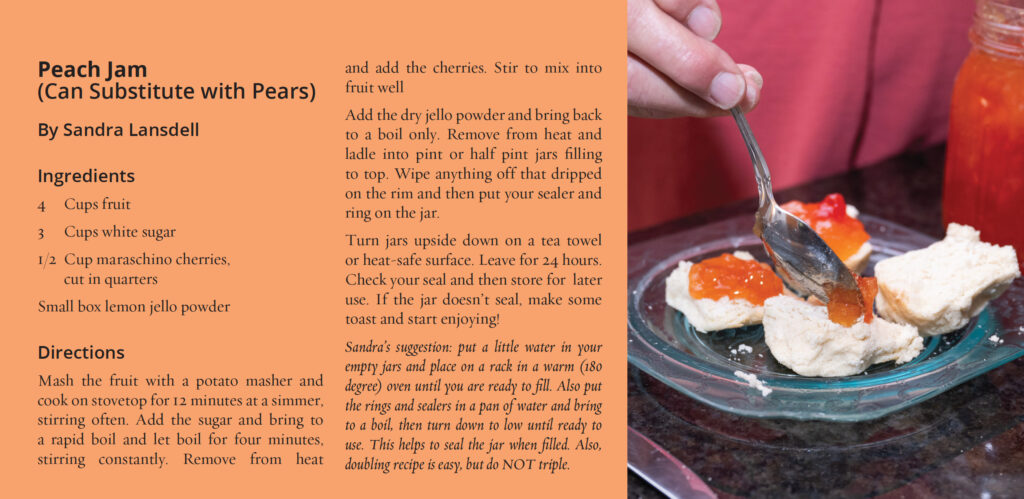Making Harvest Last

Try home canning to fill your pantry and enjoy fresh-picked flavor all year long.
By Shelley Ottenbacher / Photography by Mike Ferdinande
When Sandra Lansdell of Lenox Township stepped in to help her future mother-in-law with her home canning, she never imagined decades later she would be continuing – and expanding – the tradition.
“My mother-in-law canned just about everything,” Lansdell said. “When I started dating my husband, Roger, as a ‘good’ girlfriend, I asked if I could help her out. She taught me most of what I know.” She adds, “When Roger and I got married, we started our own garden and have been canning ever since.” Today, Lansdell cans a wide variety of homegrown foods including green beans, pickles, peppers and relish and a variety of fruit and jams, plus tomatoes, pizza sauce and spaghetti sauce, with most ingredients coming from her home garden and her own fruit trees. She stores them in her “Michigan basement” pantry which has the perfect temperature to keep them cool and dry, plus easy access all year long to enjoy.
So what is canning exactly? Basically, canning is the process of placing fresh foods in canning jars (jars with lids that seal) and heating them to a specifi ed temperature to preserve them for future use. Basic equipment can include a water bath canner, which is a large pot with a rack insert to hold jars and a lid, a canning jar lifter – large tongs to lift the jars out of the hot water – and, of course, quality canning jars, lids and rings. Water bath canning, used for high-acidic foods like fruits, tomatoes or pickles, is a simpler and less expensive method, and where many beginners start.
“You can get good jars at the grocery store, the hardware or even secondhand on swap sites or at yard sales,” said Lansdell. “You can reuse rings as long as they aren’t dented or rusted.” However, the lids should be new, single-use metal canning lids that fit your jars since they are designed with an inner gasket that softens during heating forming an airtight seal as the jars cool.
According to Ghaida Batarseh Havern, MSU Food Safety Extension Educator of the Health & Nutrition Institute at Michigan State University (MSU) Extension, the most important thing to know when starting to can at home is where to find research-tested recipes.
“We recommend using research-tested recipes because we have data on those recipes that they are safe for home canning since they were tested in a laboratory,” she said. “You can fi nd research-tested recipes on our website at canr.msu.edu/mi_fresh. Other sources are Ball Blue Book – Guide to Preserving, the USDA Complete Guide to Home Canning or the University of Georgia’s So Easy to Preserve.”
Lansdell says that online resources are helpful even for the experienced home canner “I’m still learning and always trying new things and so much information is available on websites like ballmasonjars.com,” said Lansdell. “You can find the answer or ‘how to’ for almost anything – even if you are new to canning foods.”
MSU Extension also offers programs, both online and in person, on topics from water bath canning to blanching and freezing to pickling and more. “We encourage everyone to join our free, live, weekly class called Preserving MI Harvest via Zoom webinar,” said Havern. “The class listing is updated every quarter with new seasonal topics.”
Sandra and Ghaida agree that an important ingredient for successfully preparing and preserving foods is time. A common beginner mistake is not planning adequate time, notes Havern.
Lansdell said, “I find that chopping, peeling, seeding and other prep of the fruits and vegetables is the most time-consuming part, so it’s great to do it with family or friends.” She adds, “Just like any job, it is always more fun with someone to chat with as you work.”
Don’t have a garden? Don’t let that stop you. Try visiting one of the many U-pick farms in Macomb County for your own just-picked fresh fruits to get started or one of the wonderful gourmet markets for some locally grown Michigan produce. If you’re considering investing the time and effort to home can, you might be wondering how long your canning will last.


